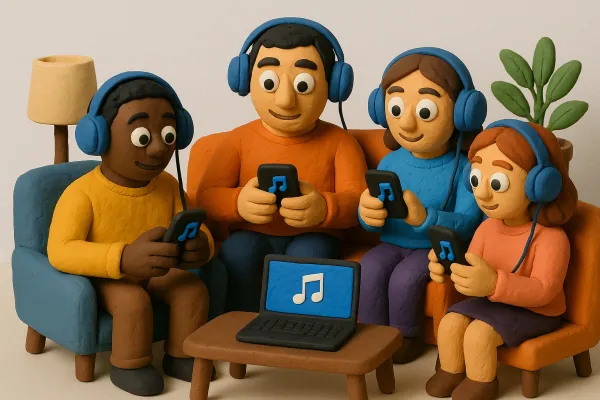Discovering Your Sound: What Is My Music Genre and How to Find It

Finding your musical identity can feel like a daunting task, especially with so many genres and influences out there. It’s like trying to find a needle in a haystack. But don’t worry! By exploring different styles, reflecting on your influences, and listening to your own music, you can start to uncover what truly resonates with you. This article will guide you through the process of discovering your sound and help you answer the question: what is my music genre?
Key Takeaways
- Experiment with various musical styles to see what feels right for you.
- Reflect on your favorite artists and their genres to guide your own sound.
- Listen to your past music objectively to identify patterns and influences.
- Pay attention to the emotions your music evokes, as they can lead you to your genre.
- Use tools like genre finders and music production software to explore and analyze your sound.
Finding Your Unique Sound
Experiment with Different Styles
We all know that trying out several styles helps us figure out what really makes our music feel like home. Sometimes we mix beats that barely go together just to see if a spark ignites. Here are some steps we take when we experiment:
- Record short demos in different genres
- Jot down what parts we enjoy most
- Use a genre finder tool to check where our mix naturally fits
We even set up a small table to keep track of our experiments:
| Experiment | Genre Influence | Our Vibe |
|---|---|---|
| Upbeat electric jam | Rock/Pop | Energetic and fun |
| Chill ambient mix | Electronic/Ambient | Calm and reflective |
| Jazzy rhythm fusion | Jazz/Funk | Smooth and groovy |
Reflect on Your Influences
After playing around with new sounds, we take a breather to think back to the tunes that shaped us. We consider what old tracks or current favorites push our buttons and why they do so. A few things we do:
- List our all-time favorite songs
- Discuss the artists who paved our way
- Notice common elements in the tunes that moved us
This self-reflection is the heart of our journey.
Looking back, we see that even the simplest melodies from our past can spark a new direction in our music.
Listen to Your Own Music Objectively
It’s easy to overlook the big picture when we’re too close to our work. That’s why we step back and review our past tracks like fresh listeners. Our approach includes:
- Taking breaks between recording sessions
- Revisiting old projects to identify consistent themes
- Asking friends for honest feedback
This process helps us spot the patterns and sounds that truly resonate, clearly pointing the way to our unique musical identity.
Understanding Music Genres
What Is My Music Genre?
When we talk about our music genre, we're looking into the unique mix of sounds that define our tracks. Sometimes, our style can incorporate a mix of beats, rhythms, or lyrics that don't fit neatly into one box. For example, we often ponder over what truly makes our sound stand out. Our music truly reflects our identity. We can get a bit of insight by checking out music genre basics to see how simple rules can sometimes guide us.
The Importance of Genre in Music
We find that knowing our genre isn't just about labels—it shapes how our work communicates with listeners. Here’s why it matters:
- It sets listener expectations, so our audience knows what vibe to look for.
- It helps us compare our sound with artists who inspire us.
- It guides the creation of our tracks as we focus on recurring themes.
Below is a quick table that shows how different genres might impact our music:
| Genre | Impact on Our Sound |
|---|---|
| Rock | Adds raw, rebellious energy |
| Jazz | Brings in improvised rhythms |
| Electronic | Elevates catchy beats |
How Genres Influence Your Sound
We believe that our chosen genre can change the way we write, arrange, and produce our music. Here are a few ways it often shows up in our creative process:
- It directs our choice of instruments and production techniques.
- It influences the mood we aim to create in our tracks.
- It helps us connect with listeners who share similar tastes.
We sometimes look back at our earlier tracks and see a subtle shift in style. This reminder helps us grow and adjust our sound over time.
In our journey, every piece we create feeds into how we refine our music style. Whether we're blending elements from different genres or sticking with what feels natural, it's all part of finding our true voice.
Exploring Your Musical Influences
Finding the music that really gets us going often means taking a closer look at the artists we admire. We decide together what really vibes with us, and this helps shape our sound along the way.
Identify Your Favorite Artists
We start by making a list of our top musicians. This isn’t just about names; it’s about what catches our ear. Some steps we follow are:
- Jotting down artists that we play on repeat.
- Noting which ones push us to try new sounds.
- Discussing with friends to see if our choices connect with theirs.
We often discover that these artists share something in common, which gives us a hint about our own musical leanings.
By looking at our favorite tunes, we often find a thread that ties our style together.
Analyze Their Music
Once we have our list, it’s time to break down what makes their music tick. We take a casual approach, listening closely to various elements. For instance, here’s a small table we use to track our observations:
| Song Element | What We Notice |
|---|---|
| Tempo | Fast beats vs. slow vibes |
| Instrumentation | Rock guitars, smooth keys |
| Vocals | Energetic vs. laid back |
We compare these notes to see trends. Along the way, we keep it fun and informal, sometimes even laughing at how one track can totally flip the mood.
Explore Their Genres
This part is all about digging into the different genres our favorite artists work in. We check out not just the main genre, but also the smaller music styles they dabble in. Our favorite steps include:
- Reviewing album notes to see the genre mix.
- Comparing similar artists across different subgenres.
- Chatting about the vibe each genre brings to the table.
By doing this, we begin to map out not only our influences but also how we want our music to sound. We’re not just copying what we hear; we’re mixing it together to create something that’s uniquely ours.
The Role of Emotion in Music
Follow Your Emotional Connection
When we start making music, we often let our feelings lead the way. Sometimes, the pure vibe of a track is born from that spontaneous emotion. We always let our heart guide every beat. It’s our natural instinct that tells us which sounds feel right, like when we suddenly vibe with a certain rhythm or chord progression. In our journey, tuning in to those instincts is key, much like the inspiration we get from music vibes.
Here’s how we jumpstart that process:
- Relax and listen to your surroundings.
- Allow feelings, both big and small, to take the stage.
- Jot down any spontaneous ideas or melodies as they come.
Notice Your Emotional Response
After diving into a track, it’s time we take a step back and really notice how it makes us feel. We might feel a spark of joy, a hint of melancholy, or even a surge of excitement. Reflecting on these reactions helps us understand the link between our emotions and our sound. Observing these cues is a bit like checking out some music vibes that guide our style.
To help us work through these feelings, we can consider these steps:
- Identify the main emotion the track stirs up.
- Rate the intensity of that feeling on a simple 1 to 10 scale.
- Note any specific parts of the music that really trigger that emotion.
For a quick look at how different feelings tie into music, check out this table:
| Emotion | Feeling | Music Genre Example |
|---|---|---|
| Joy | Light and upbeat | Pop |
| Sadness | Mellow and reflective | R&B |
| Anger | Intense and raw | Punk |
Tap into Your Personal Story
Our tunes don’t just come from external influences; they often capture pieces of our own history. Every chord and lyric can be a snapshot of something personal, adding depth and authenticity to the beat. We like to think that letting our life stories feed our music makes our sounds distinctly ours, channeling those unique music vibes that only we can produce.
Here’s a simple way to start turning memories into music:
- Think about a memorable moment in your life.
- Write down exactly how that moment made you feel.
- Let those real emotions shape the melody or lyrics of your track.
When we mix our own stories with our sound, we create something truly special that stands out and speaks our truth.
Tools to Discover Your Genre
Using Music Genre Finder Tools
We usually start by trying out a music genre finder to see where our tracks might land. It’s cool to watch tools quickly compare our work against trending genres. Here’s what we typically do:
- Check how well the software picks up on tempo and rhythm.
- Experiment with different song snippets to get varied results.
- Compare the tool’s recommendations to our own gut feeling.
We find our groove when we let the tools do the heavy lifting.
Exploring Music Production Software
Sometimes, our journey involves firing up some production software. We dive into programs that offer built-in presets for different sounds. It’s all about playing around and getting a feel for what matches our style. For a quick look, check out the table below:
| Software | Key Feature | Example Genre |
|---|---|---|
| Ableton Live | Creative loops | Electronic |
| FL Studio | Drum sequencing | Hip-Hop |
| GarageBand | Instrument layers | Pop |
We often tweak these settings to see subtle differences in tone and texture, sometimes even blending ideas from several genres.
Analyzing Song Mood and Energy
Apart from technical details, we also focus on the feel of our tracks. The mood and energy can say a lot about which genre our music is echoing. Here are a few pointers we keep in mind:
- Watch how the vibe builds up throughout a track.
- Notice how bass and high notes interact to set the tone.
- Listen for sudden changes that entirely reshape the mood.
It’s amazing how breaking down a song’s energy can completely shift our perspective on our sound.
By combining these methods, we really narrow down what resonates with us. Using our favorite music genre finder and mixing it with hands-on software exploration, we enjoy a fun and practical approach to defining our unique genre.
Evolving Your Sound Over Time
Trust the Process and Evolve
We're all on this wild ride of discovering our sound, and we know that real growth takes time. Every song we create is a little step toward defining our musical identity. Sometimes, our ideas come in fits and starts, and that's totally normal.
Here are a few things we keep in mind:
- We let each experiment build on the last.
- We welcome surprises even when things don't go as planned.
- We continuously learn from every track we produce.
Sometimes, the best breakthroughs happen when we stop forcing the process and let our creativity flow naturally.
Allow Your Sound to Change
We realize that our style might not stay the same forever. As we pick up new music production tricks and play around with different sounds, our music evolves with us. Change isn’t a setback; it's an opportunity to try out fresh ideas and broaden our horizons.
A quick glance at how our sound can shift over time:
| Period | New Elements |
|---|---|
| Early | Basic beats |
| Mid | Experimental tones |
| Now | Mixed styles |
Keep Creating and Experimenting
Maintaining our creative fire is essential. We constantly tinker with new tools—even if a lot of our early experiments are a bit rough around the edges. By pushing ourselves to create more, we open the door for unexpected discoveries. Here's how we approach it:
- We try a new instrument or tool every week.
- We record quick demos to capture fresh ideas.
- We breathe new life into old tracks with a fresh twist.
Keeping the momentum alive means we keep evolving, track by track, day by day. Let’s continue experimenting and reshaping our unique sound together.
As you grow as an artist, your music will change and develop. It's important to explore new styles and sounds that reflect who you are. Don't be afraid to try different things! For more tips on how to evolve your music, visit our website at PlaylistHub. Let's make your sound unique!
Wrapping It Up
So, there you have it! Figuring out your music genre can feel like a wild ride, but it’s all part of the fun. Just remember, it’s okay to mix things up and try new sounds. Listen to what you love, play around with different styles, and don’t be afraid to ask your friends for their thoughts. Your genre might not be a neat little box, and that’s totally fine! Keep creating, keep exploring, and most importantly, keep enjoying the music you make. Who knows? You might just stumble upon a sound that’s uniquely you!
Frequently Asked Questions
How can I find my music genre?
Start by trying out different styles. Listen to various genres and see which ones you enjoy the most. You can also ask friends what they think your music sounds like.
Why is knowing my music genre important?
Knowing your genre helps you understand your sound better and can guide your music-making process. It also helps listeners find your music more easily.
What should I do if I like multiple genres?
It's okay to like many genres! You can mix elements from different styles to create your own unique sound.
How can my emotions affect my music genre?
The music that makes you feel something special is often the genre you should focus on. Pay attention to how different songs make you feel.
Are there tools to help me find my genre?
Yes! There are online tools that can help you identify the genre of your music by analyzing it. You can enter the name of a song or artist to get started.
Can my music genre change over time?
Absolutely! As you grow and experiment with your music, your genre can evolve. It's all part of the creative process.





